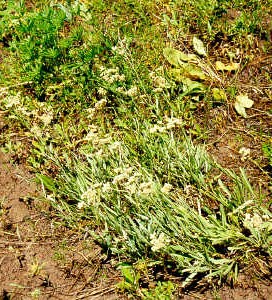Rush pussytoes facts for kids
Antennaria luzuloides is a type of flowering plant found in North America. It belongs to the daisy family and is commonly called rush pussytoes. This plant grows naturally in western Canada (like Alberta and British Columbia) and many western United States states. You can find it in Oregon, Washington, northern California, Idaho, Montana, Nevada, Utah, Colorado, Wyoming, and even some small areas in South Dakota.
Quick facts for kids Rush pussytoes |
|
|---|---|
 |
|
| Scientific classification | |
| Genus: |
Antennaria
|
| Species: |
luzuloides
|
| Synonyms | |
|
|
What is Rush Pussytoes?
Rush pussytoes is a plant that lives for many years. It grows straight stems that are greenish-white or gray. These stems come from a small, woody base called a caudex. The plant can grow up to about 25 centimeters tall, which is about the length of a ruler.
Leaves and Flowers
At the bottom of the plant, there's a group of grayish, fuzzy leaves. Each leaf is a few centimeters long. They are usually long and thin, like a line, or sometimes shaped a bit like a spoon.
The plant's inflorescence is where the flowers grow. It can hold up to 30 small, round flower heads. Each flower head is less than a centimeter wide. These heads are covered with narrow, pointed leaves called phyllaries.
Plant Reproduction
Antennaria luzuloides is a dioecious species. This means that there are separate male and female plants. The male plants produce one type of flower, and the female plants produce a different type.
After the flowers bloom, the plant produces a fruit. This fruit is called an achene. It's about 6 millimeters long and has a long, soft, feathery part called a pappus. This pappus helps the seeds float away in the wind.
Types of Rush Pussytoes
There are two main types, or subspecies, of Antennaria luzuloides:
- Antennaria luzuloides subsp. luzuloides: This is the most common type and is found across most of the plant's natural range.
- Antennaria luzuloides subsp. aberrans (E.E.Nelson) R.J.Bayer & Stebbins: This type is found in specific areas like California, Nevada, and Oregon.

